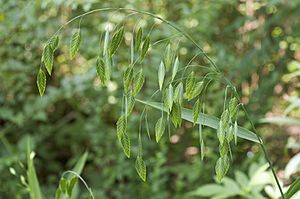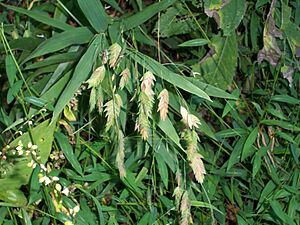Chasmanthium latifolium facts for kids
Quick facts for kids Chasmanthium latifolium |
|
|---|---|
 |
|
| Chasmanthium latifolium | |
| Scientific classification | |
| Genus: |
Chasmanthium
|
| Species: |
latifolium
|
River oats (scientific name: Chasmanthium latifolium) is a cool grass. It is also called woodoats or northern sea oats. This plant grows naturally in the central and eastern parts of the United States. You can also find it in Manitoba, Canada, and northeastern Mexico. In some northern states like Pennsylvania and Michigan, it is a rare plant. This grass used to be known as Uniola latifolia.
Contents
What are River Oats?
River oats are a type of grass. They are known as a "cool-season" grass. This means they grow best in cooler weather. They are also a perennial plant. This means they live for more than two years. River oats have underground stems called rhizomes. These help the plant spread and grow new shoots.
How Do River Oats Look?
The stems of river oats can grow to be about 1 meter (3 feet) tall. They have flat, wide leaves. The seeds hang in flat, oat-like clusters. These clusters look a bit like fish scales. They start green and turn a pretty bronze color in the fall.
Where Do River Oats Grow?
You will often find river oats in wooded areas. They also like to grow near rivers and streams. This is why they are sometimes called "river oats." They prefer places with some shade.
River Oats in Your Garden
Many people like to plant river oats in their gardens. They are a popular choice for landscaping in North America. This is because they are one of the few native grasses that grow well in partial shade. They can grow in many types of soil. This includes sandy, loamy, or clay soils. They also like acidic soil. River oats can grow in many different climates. They do well in USDA hardiness zones 3 through 9.
Why Are River Oats Important?
River oats are very important for wildlife. They are a "host plant" for some butterflies. This means that butterfly caterpillars eat the leaves of river oats. For example, the caterpillars of the Northern Pearly-Eye butterfly eat this grass. Other butterflies like the pepper and salt skipper also use river oats.
The seeds of river oats are also a food source. Many birds and small mammals eat them. This makes river oats a valuable plant in their natural habitat.


